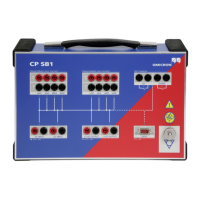
Do you have a question about the Omicron CP SB1 and is the answer not in the manual?
Important safety instructions for personnel operating the CP SB1.
Explains symbols used in the manual to indicate special safety relevant meaning.
Lists other documents that complete the information covered in the CP SB1 User Manual.
Lists the five general safety rules to observe when operating the CP SB1.
Outlines the qualifications and responsibilities of personnel operating the equipment.
Specific safety instructions for testing objects with high inductance using DC output.
Safety precautions related to the life-hazardous voltage and current from AC/DC outputs.
Discusses hazards from static charges on transformer windings.
Guidelines for manual availability, usage, and user responsibility.
States that improper usage may impair equipment protection.
Describes the CP SB1 as a transformer switch box for automated measurements.
Provides a schematic diagram of the CP SB1's internal connections and components.
Details the various components and connections on the front panel of the CP SB1.
Illustrates and labels the components on the front panel of the CP SB1.
Lists and describes the accessories delivered with the CP SB1 transformer switch box.
Describes the setup for measurements using the CPC 100 and CP SB1.
Explains how the CP SB1 and CPC 100 work together for automated testing.
Introduces the TRRatio and TRTapCheck test cards used with the CP SB1.
Safety precautions before connecting the CP SB1 to power transformers.
Step-by-step instructions for connecting the measurement setup to power transformers.
Guide on using XML templates with the CPC 100 Excel File Loader for post-processing.
Describes how to select and insert test cards for transformer measurements.
Explains the function and usage of the TRRatio test card for measuring transformer ratios.
Details how to configure parameters for the TRRatio test card.
Explains the different modes for performing measurements with the TRRatio test card.
Steps for troubleshooting the CP SB1 using the TRRatio test card.
Describes the TRTapCheck test card for winding resistance and OLTC testing.
Details parameters for configuring winding resistance tests.
Guides on how to perform winding resistance measurements.
Procedures for troubleshooting winding resistance and tap changer tests.
Details the technical characteristics and ratings of the CP SB1 device.
Outlines the operating temperature, storage, altitude, and humidity limits.
Specifies the operating temperature, storage, altitude, and humidity limits.
Details the vibration and shock test standards applied to the CP SB1.
Provides information on the weight, dimensions, and housing of the CP SB1.
Instructions for cleaning the CP SB1 safely.
Lists CE conformity, EMC requirements, and certified safety standards for the CP SB1.
Discusses practical experience in diagnosing transformers using various measurements.
Overview of transformer diagnosis methods including resistance, tap changer, and ratio tests.
Lists common test methods used to find the reason for high gas values in transformers.
Explains testing winding resistance and tap changer operation for fault detection.
Explains the necessity of four-wire connection for accurate winding resistance measurements.
Discusses safety considerations related to energy stored in coil inductance.
Explains how to calculate winding resistances for delta-connected windings.
Presents a case study of winding resistance measurement on a 100 MVA transformer.
Analyzes the dynamic behavior of the diverter switch using resistance measurement.
Explains the turns ratio test for detecting shorted turns and insulation failures.
Lists cited literature and resources related to transformer testing.